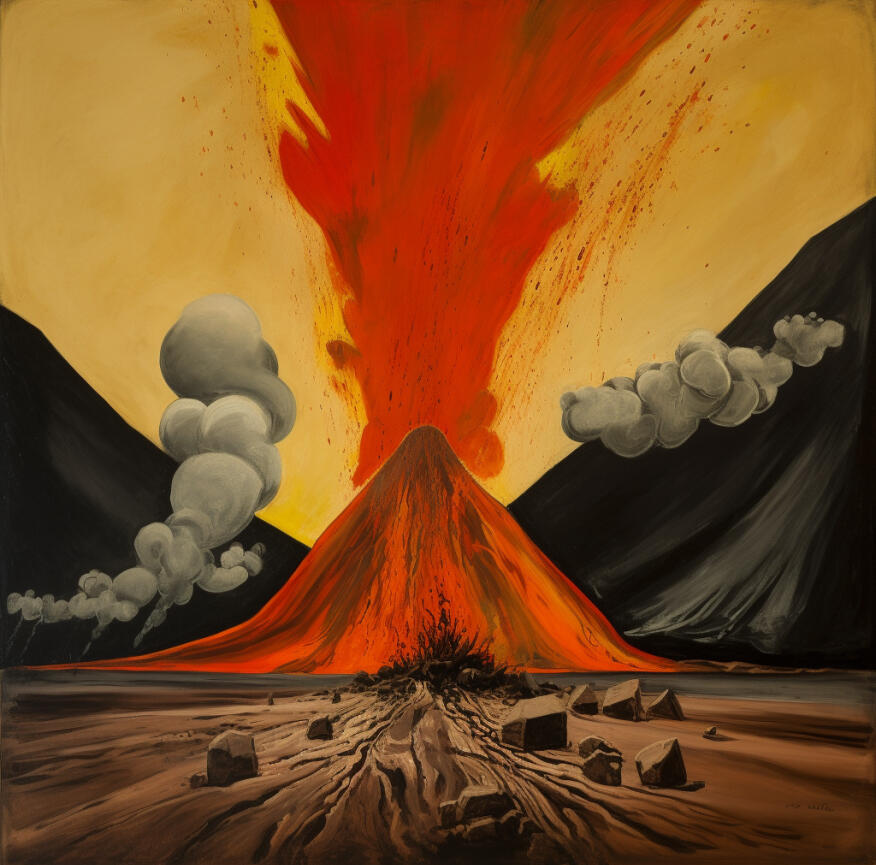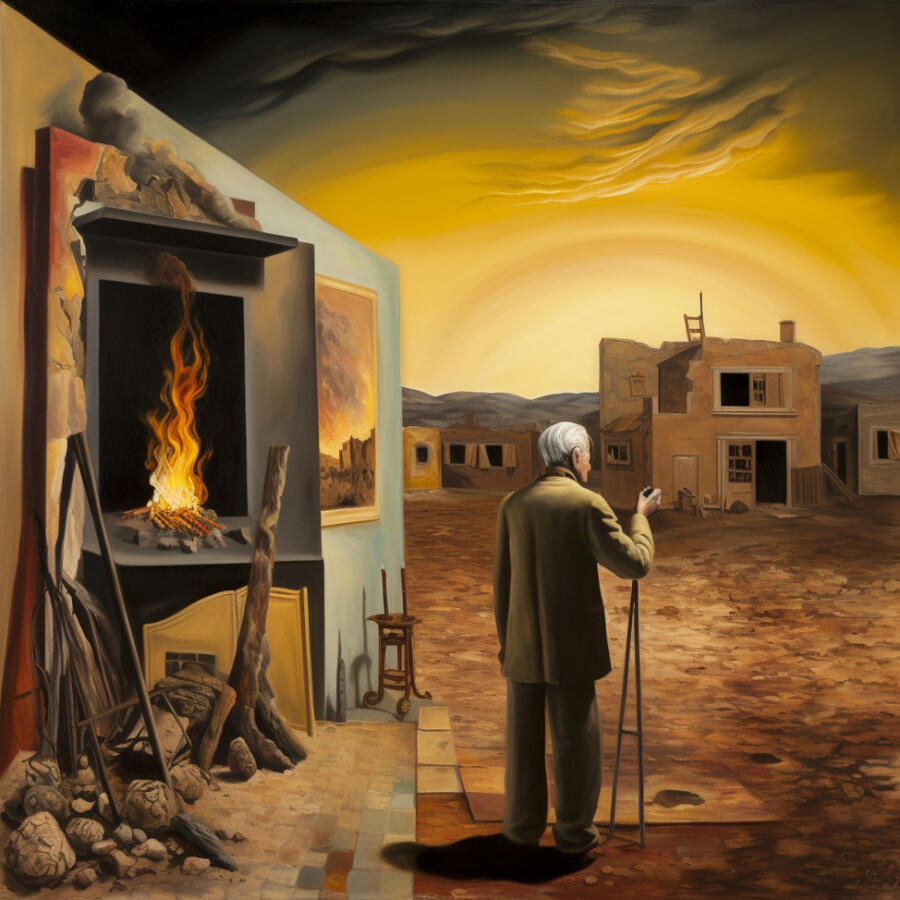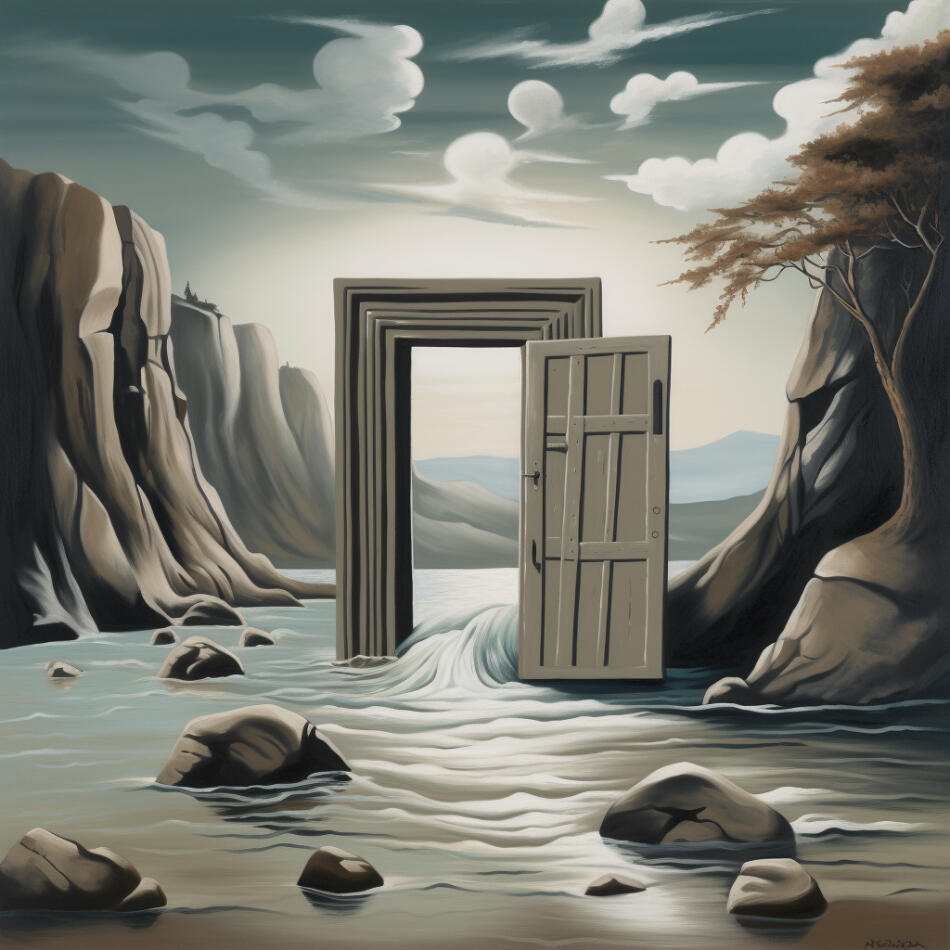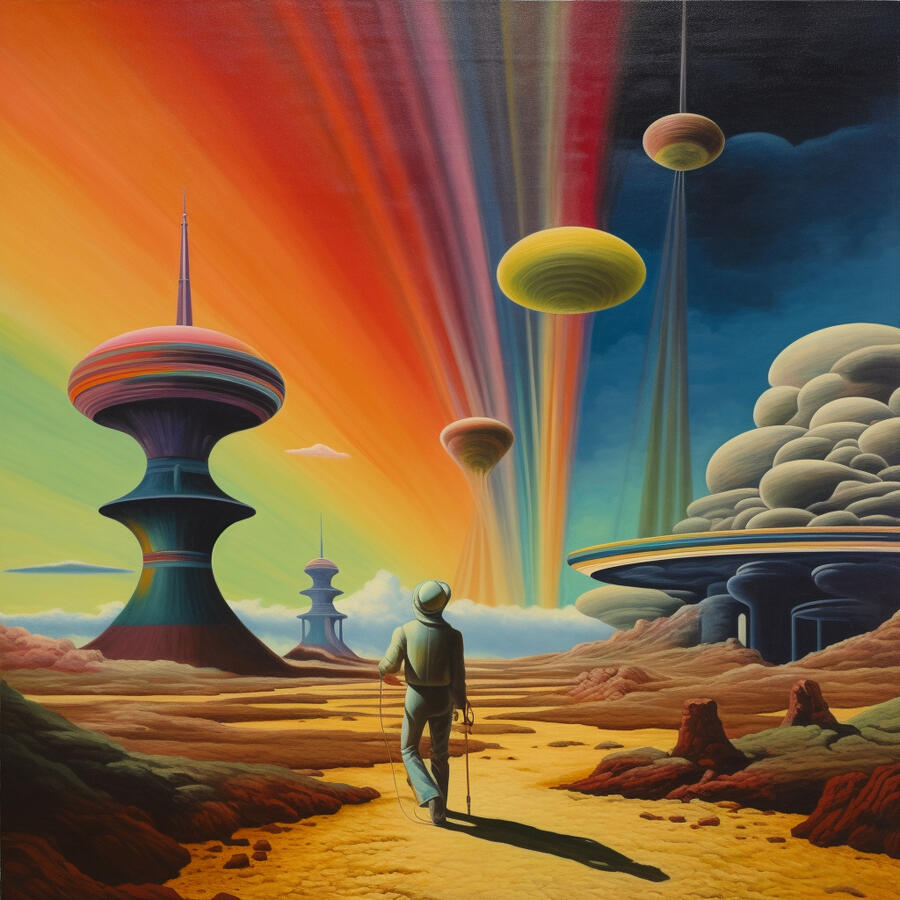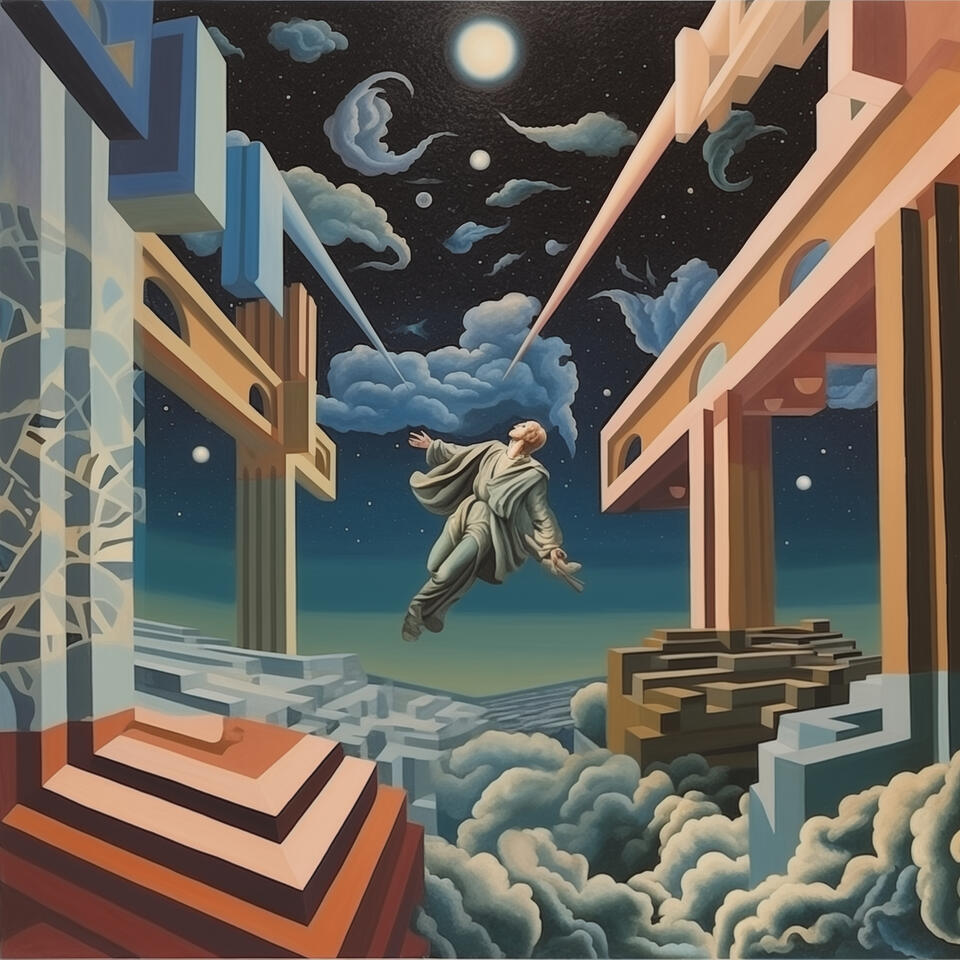
Atoms of curiosity
Exploring the Cosmic Within and Yonder
About
What do earthquakes, bacteria, and sunsets teach us about temperance, vulnerability, and equanimity? How can nature provide a contemplative framework for living an observed life?Atoms of Curiosity (why this name?) is a collection of reminders from nature about the awe and wonder of existence. From rivers to oceans, from fungi to lichens, and from neurons to neutron stars, each atom invites you to adopt a cosmic viewpoint and consider the lessons we can draw from the natural world to ensure the sustainability of our planet and future generations.Written for the scientist, the mystic, and everyone in between, Atoms invites you to explore the cosmic within and yonder, to ponder your legacy within the universe's grandeur, and to nurture a consciousness that is both intergalactic in scope and grounded in the essence of our shared humanity.
Title
The name of this project - "Atoms of Curiosity" - is inspired by a quote by late physicist and Nobel Prize winner Richard Feynman:“It is a great adventure to contemplate the universe, beyond man, to contemplate what it would be like without man, as it was in a great part of its long history and as it is in a great majority of places. When this objective view is finally attained, and the mystery and majesty of matter are fully appreciated, to then turn the objective eye back on man viewed as matter, to view life as part of this universal mystery of greatest depth, is to sense an experience which is very rare, and very exciting.It usually ends in laughter and a delight in the futility of trying to understand what this atom in the universe is, this thing—atoms with curiosity—that looks at itself and wonders why it wonders. Well, these scientific views end in awe and mystery, lost at the edge in uncertainty, but they appear to be so deep and so impressive that the theory that it is all arranged as a stage for God to watch man's struggle for good and evil seems inadequate.Some will tell me that I have just described a religious experience. Very well, you may call it what you will. Then, in that language I would say that the young man's religious experience is of such a kind that he finds the religion of his church inadequate to describe, to encompass that kind of experience. The God of the church isn't big enough.”― Richard P. Feynman, The Meaning of It All: Thoughts of a Citizen-Scientist
Atoms
To receive updates about Atoms of Curiousity, type in your email and subscribe below
Earth
Preciousness

On February 14, 1990, the Voyager 1 spacecraft, 6 billion kilometers away and en route to Saturn, turned its camera backward and took a photograph of the Earth. The photograph shows a pixel-sized blue Earth suspended into vast, expansive, dark space.The photo — now known as the Pale Blue Dot — was taken at the request of astronomer and scientific disseminator Carl Sagan, who argued that it would be a valuable reminder of our place in the universe and of the fragility and uniqueness of our host planet.The Earth, the third planet from the Sun, was formed 4.5 billion years ago, in the early “days” of the solar system, when collisions between debris and other escape bodies formed the planets as we know them. It is thought that an impact between the early Earth and another protoplanet caused a massive release of energy, which led to the formation of the Moon and the structural differentiation of the Earth’s interiors into core, mantle, and crust. The geological processes that have occurred since then have shaped the planet's surface and atmosphere and have played a crucial role in the evolution of life on Earth.Earth is our only home. Unless you’re an astronaut, your entire life will happen on the face of the Earth. It is humbling that in the vastness of space, we can only exist — at least for the foreseeable future — on this “mote of dust, suspended in a sunbeam”. More precisely, we exist on the lowest layer of the earth’s atmosphere - the troposphere - a tiny little film of air around the planet which contains a precious cocktail of nitrogen, oxygen, argon, and other gases conducive to biological life. If the Earth were the size of a basketball, the thickness of the troposphere could be modeled by a thin sheet of plastic wrapped around the ball. In the vastness of the universe, the human niche is miniscule and delicate.Some life forms, like microbes and bacteria, have evolved to survive and thrive deep below sea level or at high altitudes. Humans would require a massive infrastructure of thermoregulation and air filtration to survive at these extremes. Simply put, as humans, we can only easily breathe, live, and thrive in the troposphere. If we go a few miles deep below sea level, or a few miles higher into the stratosphere, we perish. We exist inside an impossibly thin and fragile layer of ecological splendor, beauty, and perfection. In it: all the trees, lakes, rivers, animals, insects, birds, viruses, and humans that are, were, or will ever be.Fast forward to a not-so-distant future. Voyager 1, traveling in interstellar space, has reached the Oort Cloud in the outer boundaries of the solar system. Meanwhile, intelligent advanced species inhabiting Kepler 22-b, a planet orbiting Kepler-22, a star in the constellation of Cygnus, turn their telescopes towards a mysterious "extrakeplerian" world. Their astronomical prowess has flourished, enabling them to detect and study distant planets as they pirouette in the habitable zones of far-off stars in their galaxy. Their latest finding? A rocky sphere, not unlike their own, encircling a G-type star, 635 light-years away. They dub this newfound world the Pale Grey Dot, or PGD — the name derived from the grey pixel that their instruments detect, and a testament to a gaseous atmosphere swirling above its surface.A frenzy of speculation erupts on Kepler-22b. Scientists, bloggers, and journalists alike wonder if PGD could be "the one"—their elusive chance to commune with another intelligent species. For a brief moment, hope sparkles in the hearts of a distant civilization, united by a shared dream of cosmic companionship.But, as Keplerian astronomers perform spectroscopy on PGD, peering deeper into the chemical composition of its atmosphere, their hopes are dashed. While the size, position, and geological makeup of PGD are very promising, its atmosphere is laden with carbon dioxide and heavy gases, making it inhospitable to organic life.Scientists of SEKI (Search for Extra Keplerian Intelligence) make an attempt at radio connection, only to be met with the deafening silence of the void. Undeterred, they attempt to calculate what the voyage to PGD would entail—a journey of over a millennium with their current technology, traveling at nearly half the speed of light. The cost of such a journey, both in time and resources, weighs heavily on their collective hearts. And so, after some time, they abandon it, focusing their time and attention on other worlds.Years pass on Kepler-22b. One day, a bright, imaginative child stumbles upon the forgotten tale of the Pale Grey Dot. In a flash of insight and imagination, he dreams up a time before PGD's skies turned ashen. Maybe the Pale Grey Dot was not always gray and unlivable. Maybe those thick carbon clouds are the result of a climate crisis that scorched and tainted the planet.He dreams of snow-capped mountains, pristine lakes, and bountiful oceans beneath a blue sky, where birds and clouds weave together; he dreams of rivers teeming with colorful fish; of expansive steppes populated by majestic animals that roam the land with grace and dignity. As the child's imagination takes flight, he sees humans roaming through prehistoric settlements, wise and foolish, kind and cruel, at war and peace. He witnesses the slow march of progress and the spark of scientific invention. He sees the planet covered in awe-inspiring architectural marvels that pierce the sky, their spires reaching up as if to touch the heavens. In the midst of this kaleidoscope of earthly life, the child feels the love of a hundred billion mothers for their children.And so, for a fleeting instant, the ephemeral beauty and preciousness of that pale blue dot flickers back to life in the imagination of a young dreamer on a distant world.
Volcanoes
Vulnerability
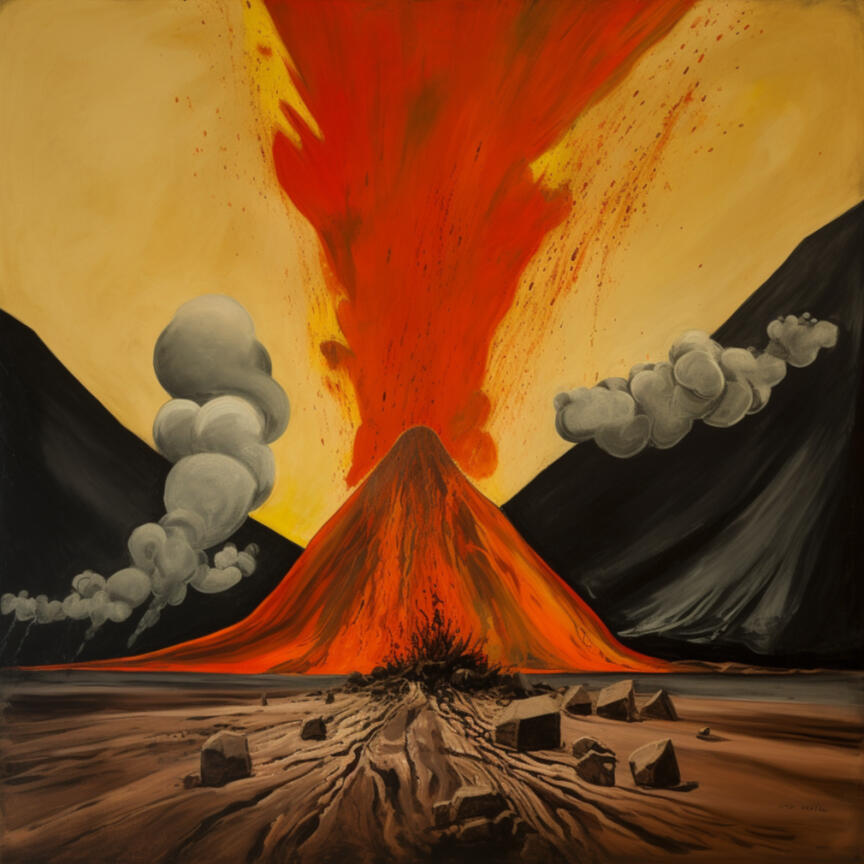
Beneath our quiet and reserved demeanor, sometimes a tempest is silently brewing. Today, we feel sullen on the inside, but on the outside, we maintain the composed expression that our friends, loved ones, and colleagues have come to recognize. Our best friend agreed to meet us for tea, sensing that something is amiss. “What’s going on?”, they ask. “Nothing” we reply. Little do they know that we are quietly bleeding from a thousand paper cuts. That our heart, today, is shattered into a million pieces. That the argument we just had with dad seems insurmountable. That the neck pain is back, and today was the worst we have felt in a long time. Our wounds, lately, have become unspeakable. And indeed, oftentimes, we do not speak. We brush it all under the carpet. Till the day we fill up to the bream. Like a volcano sitting at the confluence of two tectonic plates, uncontrollable subterranean movements rip open. The earth cracks. Emotions, like molten lava, explode in a fiery eruption, setting the sky on fire.The English word "volcano" (and all its uses in romance languages) derives from the name of the Aeolian Island of Vulcano, nested between Palermo and Naples in the Tyrrhenian Sea. The Romans believed that this tiny island was the chimney of Vulcan, the god of fire.Volcanoes are ruptures in the crust of a planet. During an eruption, lava, ash, and gases are released from a magma chamber below the surface. On Earth, the process of volcanism is driven by the movement of tectonic plates and the internal heat of the planet.While all volcanoes involve the same basic process of magma and ash erupting from the Earth's crust, there are several different kinds of volcanoes: cinder cones, composite, shield, and lava domes. The differences reflect the shape of the volcano, the number of vents, the composition of the ejected material, the frequency and nature of eruptions, and the type of lava flow, among other geological characteristics.Volcanoes show us a glimpse into the interior of our planet. Each eruption is a brief expression of what is on the inside, beneath the crust. Our psyche is not unlike that of a volcano. We erupt each time we release an untimely laugh or an awkward mannerism, uncovering a forbidden, vulnerable part of ourselves. We erupt when we explode into an episode of uncontrollable anger. We erupt with tears that cascade when least expected, at times dripping and bubbly, at others impetuous and viscous, leaving us raw and exposed. In those moments, we feel fragile and ashamed, as if our Vesuvian outbursts have laid bare the darkest, most intimate corners of our souls — the tender and the fierce, the fearful and the confrontational. When we refuse to bear witness to our own vulnerability, we forsake and curse the natural fabric of our identity.But then, from time to time, a serendipitous encounter, a whispered confession, or a gentle nudge from a friend, a lover, a therapist, or a stranger, changes everything. Their invitation to listen — to understand — provides the solace we so desperately seek. They offer the space to let us be vulnerable, to unashamedly open up, to let the lava flow, flagrantly offering up what’s beneath the crust. And in these moments of profound openness, we discover that vulnerability is the very essence of our being, the natural state that connects us all. For it is only in the free fall of vulnerability that we can truly achieve catharsis, finding solace and strength in the knowledge that we are not alone, and that our lives are woven together by the fragile threads of our shared humanity.
Fire
Community
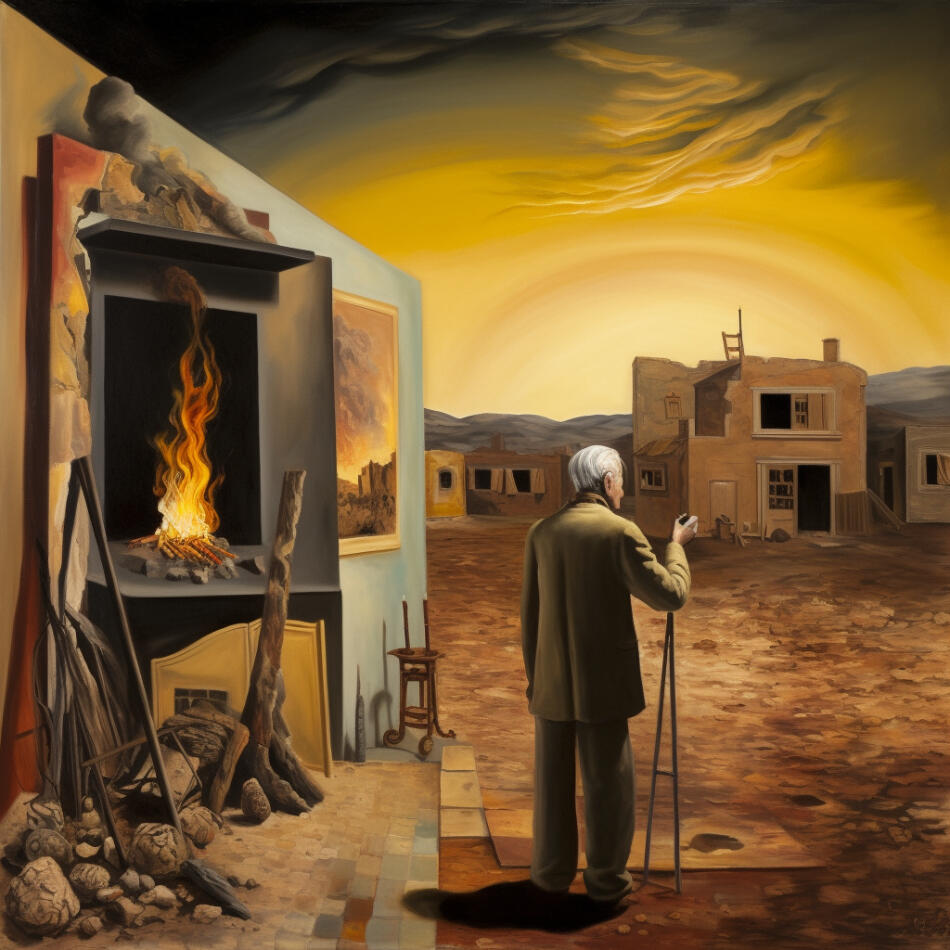
It was my grandfather who first taught me how to light a fire. During the chilly winter months, every afternoon he would venture into the backyard to collect various sizes of wood, and carefully arrange them beside the fire pit in the patio of his rustic, cozy, multi-family home. Living just next door, in the same housing complex, I was fortunate enough to spend my afternoons helping him with this cherished ritual.As the sun set, my grandfather would carefully assemble the wood, using old newspapers as tinder. His technique involved making “a teepee”: he would build a cone leaning small pieces of kindling against each other. He intentionally left gaps in the teepee for airflow and a small opening to ignite the tinder. Once the fire was crackling, he would oftentimes warm a piece of stale bread by the fire, turning it into a hot, crunchy, and slightly charred treat. A splash of olive oil completed the appetizer, which he shared with the family before dinner. The taste remains a fond memory for me. Drawn to the fire's warmth and light, as well as the charred bread, family members would gather around.My grandfather’s fire not only provided heat, but also marked the transition from the day of work to a more relaxed evening, filled with shared meals and stories. My grandfather's war stories were everyone's favorite, as we listened intently with the firelight illuminating our faces. The power of the fire to bring my family together was a testament to its enduring significance to unite in human history.Fire is a chemical process — known as combustion — in which a fuel reacts with oxygen, releasing heat, light, and various gaseous byproducts, such as carbon dioxide and water vapor. Although early humans first stumbled upon fire as far back as one million years ago, it wasn't until a couple of hundred thousand years ago that they began to harness and control its power systematically and deliberately. All it took was a tiny ember to ignite dried grass or wood, and soon enough, humans learned to start fires using friction or sparks created by striking rocks together.The impact that the control of fire had on the evolution of human culture is hard to exaggerate. Fire allowed for the cooking of food, which not only increased the variety and accessibility of nutrients but also reduced disease by eliminating harmful microorganisms. Additionally, fire helped people stay warm in cold weather, extending the human niche to areas of the globe that would have normally been too cold for human living. Fire was instrumental in numerous aspects of human life, from agricultural land clearing to signaling, cremation, metalworking, and even in the darker aspects of history, such as torture and destruction.Fire also dramatically and forever changed our habits, making it possible to extend daylight hours into the darkness of the night. While the daytime was devoted to work — hunting, gathering, farming, and childcare — the evening fire fostered a communal space for dancing, strategizing, sharing meals, and gossiping. It was around these fires that the most significant elements of human culture were forged and solidified.In later years, my grandfather became too old and frail to light a fire every evening. My grandmother took over the task occasionally, but it became a chore more than a treat, since a lot of us were not around the house anymore and the magic of the communal fire had been extinguished. Family members who used to live in my grandfather’s multi-family home had moved out years earlier, to new more modern homes, in the residential outskirts of town. My siblings, my cousins, and I moved out too, to go to college or to start a life in other parts of the country. The warm glow of those communal dinners had been replaced by the cold glow of the television screen. More recently, even the TV has been superseded by the more isolating and personalized glare of the smartphone.On some nights, as I dine alone in my climate-controlled, technology-filled apartment, I dig through the ashes of memories past. In the smoldering remains of that old teepee fire, I search for an ember still glowing, and radiating enough heat to rekindle the fire that once was.
Rivers
Change
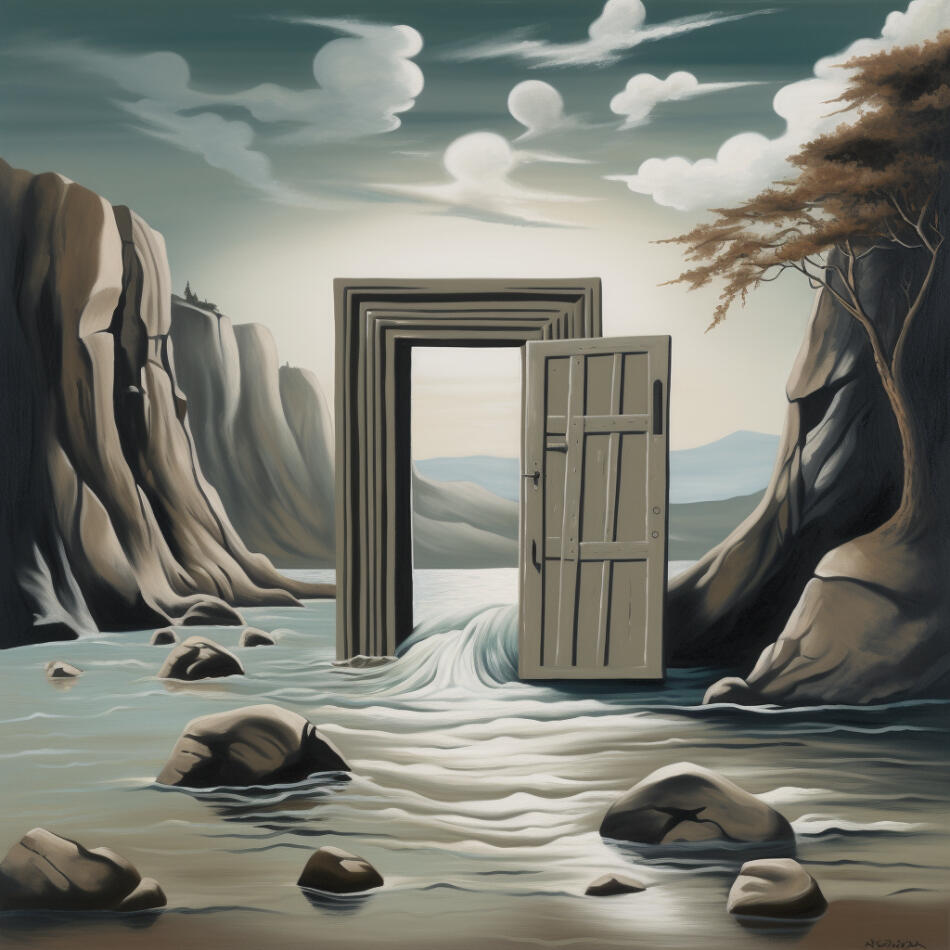
We are who we are because of the trillions of decisions, events, obstacles, and coincidences that took place in our lives. Unfathomable and unforeseen, our journey led us to this very moment. I, for one, could have never predicted finding myself here, standing at this exact intersection of my life's myriad threads: living a fulfilling life in a country thousands of miles away from my place of birth; speaking and writing in a language I did not know during the first half of my life; graced and supported by a community of eclectic, genuine friends, passionate co-workers, and fervent, beautiful lovers. We build our lives and identities one step at a time. Running like a river, our lives are in constant flux, with water swirling around rocks and boulders in predictable and less predictable ebbs and flows.Rivers are water streams — the Earth’s way to redistribute water across the planet and sustain life. Rivers span across all continents and carry water from mountain glaciers, springs, and underground streams to sea, oceans, and lakes. Rivers have had a critical role in the development of civilization. Some of the world’s most important cities are situated on rivers. Think of the Thames, the Danube, the Seine, the Nile, the Tigris, the Hudson, or the Tiber, and you will think of the cities and empires that were built on their banks. This is not by accident. Rivers have been used by animals for drinking and bathing since the dawn of biological life, and by humans for transportation and irrigation for tens of thousands of years.Rivers are the Earth's arteries, flowing through the planet's body, pulsing with the vital life force of water, connecting disparate regions just as our circulatory and nervous systems weave intricate webs throughout our bodies. Just as arteries carry the sustenance of oxygen and nutrients to every cell, rivers transport life-giving water, shaping the land, nurturing ecosystems, and enabling the rise of civilizations. The comparison between rivers and arteries doesn't stop at their functional roles. Both rivers and arteries represent systems in a constant state of flux. Just as rivers are perpetually renewed by the waters that flow through them, our bodies too are in a continuous process of transformation. Our cells are incessantly regenerating, dying, and being replaced, in an unending cycle of life, death, and rebirth. Our identities, much like rivers, are not static, but dynamic and ever-changing."No man ever steps in the same river twice, for it is not the same river and he is not the same man." The words of ancient Greek philosopher Heraclitus offer a profound reflection on the ever changing nature of existence. If everything is in perpetual flux and if the particles that constitute us are endlessly shifting and rearranging, what does it mean to be the same person? What does it mean for a river to be the same river? Where does a river start and finish? In the physical sense, a river begins at a source and ends where it meets the sea. But the water within it, constantly flowing and changing, defies such straightforward delineation. Similarly, you may define a person by their physical body or their conscious experience. Yet, the atoms that form us are constantly being replaced, and our minds are shaped by a ceaseless stream of experiences.You and I are rivers. And as rivers, we are not defined by the water that flows through us at any given moment, but by the courses we etch across the land. We are not a mere bag of atoms or the sum of all the thoughts in our minds. We are the change, an ever shifting, fluid identity, shaped by the enduring patterns of our existence. We are the stories we live, the impressions we leave, the change we weave. In the ballet of existence, our identity lies not in the number of steps we take, but in the dance itself.It is in moments of suffering and grieving that our river-like identity becomes apparent and unavoidable, when the currents of life take unexpected turns. When a romantic relationship ends; when we face the death of a dear friend; when a project we have been working on collapses, we are shocked with a new reality. Life's flow is no longer on autopilot: a metaphorical boulder obstructs our path, forcing us into a sharp collision.In these moments of hardship, we yearn to maintain our course, to swirl around the rock, and resist the inevitable change. But, sometimes, the obstacle in front of us is too large to circumnavigate. The impact with it reverberates through our being, creating turbulence that demands a shift in direction. The river of our existence ought to renew itself, carving a new path, reshaping our fluid identity.
It is in the privacy of our hearts that we summon the courage to change course. We let go, allowing the river to show us the way — the natural way to ride the turbulence and bring us to a new path of balance. It is at these pivotal moments that we embrace the change. We become it. Running as rivers, we shift and turn; we merge and converge, to form new majestic torrents; we find tributaries leading us to uncharted territories that beckon us with the promise of growth and renewal; we become the rapids, rushing with intensity. We become waterfalls when the river bed below us disappears entirely, and we let our hearts cascade in free fall.As I embrace change in my own life, I see my own river with a new perspective. I realize that the path to this moment — to the here and now — was not always smooth and pleasant. It was the tumultuous rapids, the towering dams, and the cascading waterfalls that sculpted me into the person I am today. With every tear I shed today, I honor the grace and resilience with which I have navigated the currents of life up to this point. With every tear I shed today, I welcome the sea of possibilities that await beyond the river’s bend.
Earthquakes
Impermanence
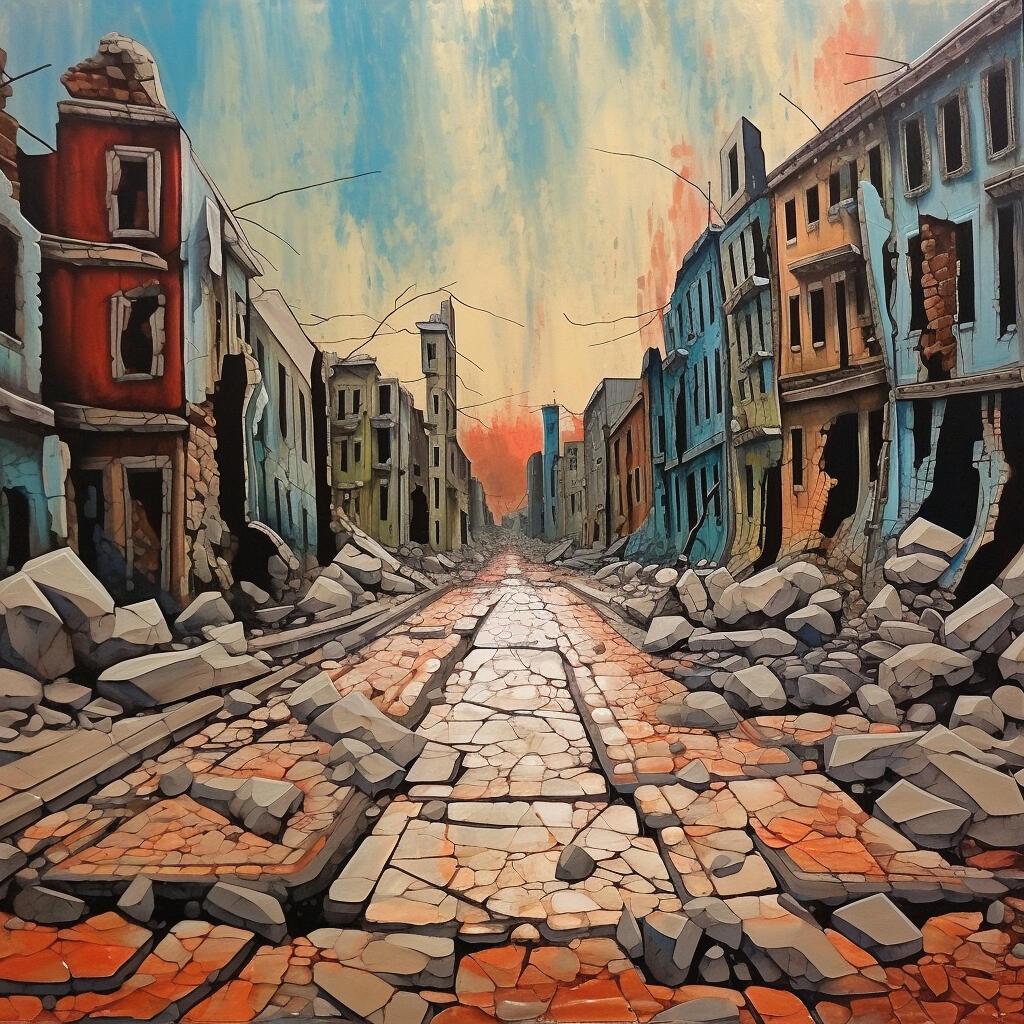
On the first of November 1755, a 8.7-magnitude earthquake completely devastated Lisbon, Portugal, killing 50,000 residents, and bringing the city to ruins. It is one of the most destructive earthquakes in history. It literally shook the cultural consciousness of Europe, in the middle of its enlightenment period. The earthquake caused widespread panic and confusion, and many struggled to make sense of such an unexpected and destructive force of nature.One of the most notable responses to the earthquake came from French philosopher Voltaire, who wrote a poignant and somber poem reflecting on the tragedy and the broader implications of natural disasters. In the poem, Voltaire suggests that evil and suffering are an inherent part of the universe, and that even the most advanced civilizations are vulnerable to the forces of nature.To us, earthquakes are agents of destruction. They unravel buildings, destroy cities, tear down bridges, and kill lives. Across cultures, eras, and geographies, humans have developed their own ways to understand and cope with earthquakes. Yet, the Earth has shaken for most of its history. Long before humans were on the face of the planet, the Earth was already being reshaped and reconfigured through constant bouts of sudden and precipitous motion of its surface.Most earthquakes are caused by the rupture of geological faults, which are in turn the result of the slow movement of tectonic plates over the course of billions of years. These plates shift and collide, creating friction and energy which can be released suddenly and violently in the form of an earthquake. Akin to conductors of a philharmonic, earthquakes direct an orchestra of tectonic plates drifting across the Earth’s crust.
Seismic events last typically only a few seconds — one or two minutes, at most. In terms of “geological time”, one minute is an absurdly short and imperceptible length of time. Geological time is the vast expanse of time in Earth's history, spanning from the present, back to billions of years ago to the formation of our planet. Geological time is used by geologists, paleontologists, and other scientists to describe the age of rocks, long historical eras, and the movement of continents. It is peculiar that earthquakes, while being so brief, are the expression of the Earth’s longest and “deepest” concept of time. Yet, earthquakes offer a glimpse into the Earth's long, rich, and complex history.An earthquake is the Earth’s built in alarm clock — sudden, abrupt, loud, and terrifying. When an earthquake strikes, it is a powerful reminder of the impermanence of all things. Buildings, cities, and entire landscapes are transfigured in an instant. Continents glide, mountains rise, and canyons carve. Earthquakes are a natural part of the Earth's ongoing evolution and transformation.In Buddhist philosophy, the concept of anicca, or impermanence, teaches that everything in the universe is constantly changing and in a state of flux. Anicca is a a natural part of the cycle of existence, and it touches all things, including the Earth itself. Nothing is permanent. Everything must eventually come to an end, including mountains, oceans, and even the Earth. Anicca serves as a reminder to live in the present moment and to appreciate its beauty and transience. The permanent motion of the Earth remind us of our own impermanence.On a sunny morning of a distant future, long after the last surviving human has vanished from the face of the Earth, an earthquake will strike with unseen force and destruction. It will be one of many quakes that have reconfigured the entire face of the Earth, destroying most evidence of human existence, and reshaping continents and landscapes. This specific earthquake will have its epicenter right below what once was the city of Paris, in France. With its unprecedented force, it will rend some of the finest structures of human culture and architecture into a pile of rubble and debris. A deep silence will descend upon the City of Light, broken only by the sound of stones grinding against one another.If a solitary soul were there to witness this scene, they could see the shattered tomb of Voltaire, reduced to a thousand pieces, in the fallen crypt of the Panthéon.
Mediterranean
Rhythm

You are drifting off to the rhythmic sound of the sea and the warmth of the sun on your skin, as you lie on a sandy Southern Italian beach. The Mediterranean breeze caresses your face, lulling you into a dreamy state. Then, suddenly, you awaken, feeling parched and disoriented, wondering how long you've been sleeping. As you look up, you sense that time has passed, but you're not quite sure how much.The sun has shifted its position in the sky, casting a different quality of light upon the beach. The rays feel like a soft, velvety blanket, evoking memories of summers past. You squint, trying to gauge the time of day. Looking around, you realize the beach is no longer bustling with activity. The once crowded shoreline is now quiet and serene, with only a handful of people scattered about.You notice a couple lounging on a rocky outcropping by the shore, their bodies glistening in the sun. In the distance, two boats sway gently with the rhythm of the waves. The only sound is the lapping of the sea against the shore. The beach is nearly empty, as if the world has gone on without you. Perhaps everyone has gone home for lunch.The Mediterranean is a small, enclosed, body of water located between Southern Europe, Northern Africa, and Western Asia. It is connected to the Atlantic Ocean by the Strait of Gibraltar. The Mediterranean has played a rich and important role in human history. Some of the most prominent Western civilizations flourished on its shores and battled for its control - the Egyptians, the Greeks, the Romans, the Phoenicians, and the Byzantines. The Romans called it “Mare Nostrum”, Our Sea. It is possible that the Romans already felt that there was something special about this enclosed sea. Yet today, the Mediterranean is also the resting place of tens of thousands of migrants who attempt the crossing from the North African shore into Europe in search of shelter, jobs, and peace.Unlike oceans, where high and powerful swell waves generated thousands of miles away hit the shores, sometimes with extreme force, the Mediterranean Sea is a wind-wave environment. As such, the waves tend to depend on the wind: Sirocco, Meltemi, Leveche, Tramontane. Residents of the Mediterranean know well the names, joys, and trials of different winds. Yet, even when the winds are very strong, the waves generated in the Mediterranean are never so high and powerful as those in the Atlantic. It’s as if the Mediterranean was created to be a more human-scale sea.
In the 1980s, urban philosopher Henri Lefebvre set out on an ethnographic study of the rhythms of everyday life in urban environments. His work, called rhythmanalysis, casts lights on the complex rhythms of life in the Mediterranean - a life in which the incessant, gentle rhythm of the waves dictate social, religious, and cultural norms.So, maybe you were right, after all. The beach crowds must have left to go to lunch. As you come back to your senses, memories flood back to you. Memories of that day in Southern Italy, when your stomach grumbled at 4pm, and the restaurant staff shook their heads, pointing to their watches. The time window for lunch had just passed, and you were left famished.Everything falls into place. Amidst the turmoil of the Mediterranean, there is a cadence, a natural order. Bells chime in the narrow alleyways of Alicante, heralding the dawn of a new day. The aroma of simmering tomato sauce on the streets of Pantelleria marks the onset of the locals' lunch break. Across the water, in Tunis, the Great Mosque beckons the faithful with its mesmerizing call to prayer. The sun sets in Santorini, signaling the time for the first glass of tsipouro. In Tel-Aviv, the city siren blares, announcing the arrival of Shabbat on a warm Friday afternoon.The Mediterranean beats to the rhythm of its people, a symphony of life and culture, strife and conflict. With each passing moment, its pulse grows stronger, more enchanting, and yet offbeat with the history of human sacrifice. A polyrhythm impossible to reconcile.
Rainbows
Wonder
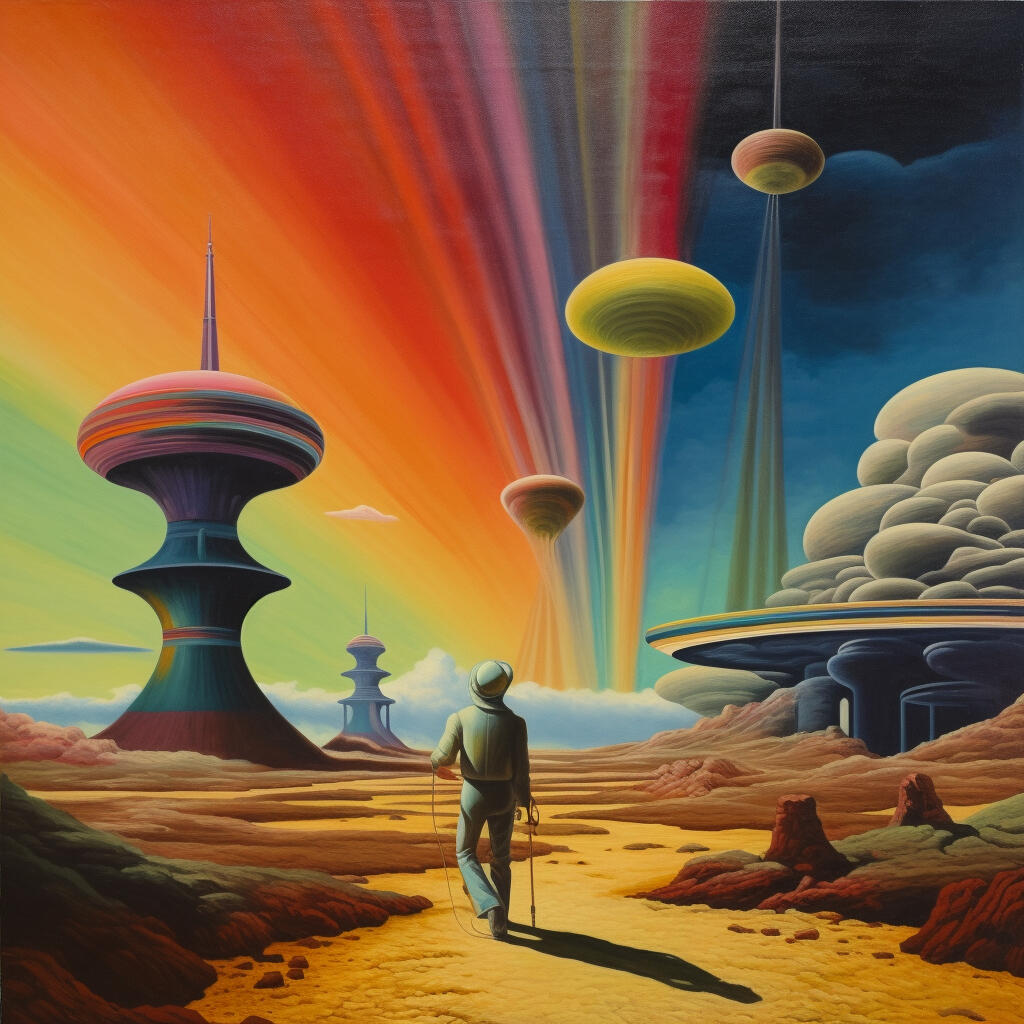
In the year 2222, humanity finds itself in the throes of a monumental task: manufacturing a rainbow on Mars. To comprehend the significance of this seemingly eccentric feat, we must rewind our clocks three million years back, to the first moment a rainbow captivated our conscious eyes. Imagine a young female homo habilis rummaging through the rolling grasslands of present-day South Africa, gathering seeds, fruits, and nuts. Suddenly, the light dims, as a system of gray clouds fills up the sky above her. A summer rainstorm ensues, forcing our bygone ancestor to seek shelter in a nearby cave up the hill. When the storm subsides, she resumes her gathering, until she is enthralled by something in the sky: a rainbow.She stands motionless, transfixed. “What is it?” she wonders. How could the sky be painted by a palette of such vibrant colors? This nameless ancestor of ours — the mother of all our mothers — was the first to experience the power of the rainbow. She held her breath and stood, face to face, for the first time in history, with something commensurate to the human capacity for wonder. Could it be that this exact moment heralded the dawn of human civilization?Rainbows are created when sunlight meets airborne water droplets. Light in a rainbow is refracted, reflected, and dispersed. When sunlight encounters a raindrop, it first refracts (bends) as it enters the droplet. The light then hits the inner surface of the raindrop and reflects off, bouncing back towards the other side of the drop. As the light exits the raindrop, it refracts again. This double refraction and internal reflection process causes the light to disperse and forms a spectrum of colors. The arresting beauty of rainbows is a ballet of light and matter.Over the centuries, the charm of rainbows pervades human mythology and symbolism, representing hope, renewal, and divine messages. The ancient Greeks deified the rainbow in the form of Iris, the messenger of the gods. This mythological legacy is echoed in the Spanish word for rainbow — arcoiris — encapsulating both its physical shape and its metaphysical significance.The intrigue surrounding rainbows deepened with the advent of scientific inquiry. In the 17th century, Isaac Newton unraveled the mystery behind the rainbow's color sequence. With his groundbreaking prism experiment, he illuminated the principles of optics and light dispersion. Wondrously, it was a rainbow that pushed the boundaries of human knowledge and laid the foundations for modern physics.Let’s now roll our clocks forward to the year 2222. Humans find a new home on Mars after fleeing from a warming Earth suffocated by pollution and neglect. Scientists and engineers work tirelessly to terraform the Martian, barren landscape into a living, breathing world. Even with foreign soils and materials, a different gravity and atmosphere they enable human survival. Mars now boasts housing complexes, football stadiums, hospitals, and skyscrapers.During this terraforming operation, the colony of scientists working on Mars needs more resources from their home planet, but they do not demand more engineers and scientists. Instead, they ask Earth to send a convoy of artists, designers, philosophers, and poets. Something is amiss on Mars, but they cannot put their fingers on it. Could artists and visionaries help? The “Buckminster” mission is born, bringing to Mars the best creative minds that Earth has to offer.After months of living on the new planet — contemplating on the very core principles of creativity, purpose, and imagination — the artists on the “Buckminster” mission finally unveil a detailed report of what is missing on Mars: a rainbow. They claim the desire to see a rainbow arch across the Martian sky is not merely a whim, but a necessity; a symbol of our longing for wonder.Utilizing advanced nanotechnology and atmospheric engineering, scientists work to create the conditions to birth rainbows at random intervals. They introduce carefully designed micro-droplets into the developing Martian atmosphere. Each droplet, a tiny prism, bends and scatters sunlight that travels through time and space, into a breathtaking palette of colors. The first Martian rainbow is more than just a scientific achievement. It is a symbol of hope and resilience for a nascent civilization.In the historical arc of human consciousness, connecting the plains of ancient Africa to the terraformed lands of Mars, there's a thread that weaves you into this cosmic narrative. As your conscious eyes finish reading these words, your mind may wander to the next meeting on your calendar, the email you have been putting off writing all day, or the text message you have been waiting to receive all week. Lest you become distracted by the mundane routine of day in and day out. The hues of a rainbow will paint your sky again soon, dear reader, honoring the very wonder that moved us through eons of human history.
Black Holes
Ineffability
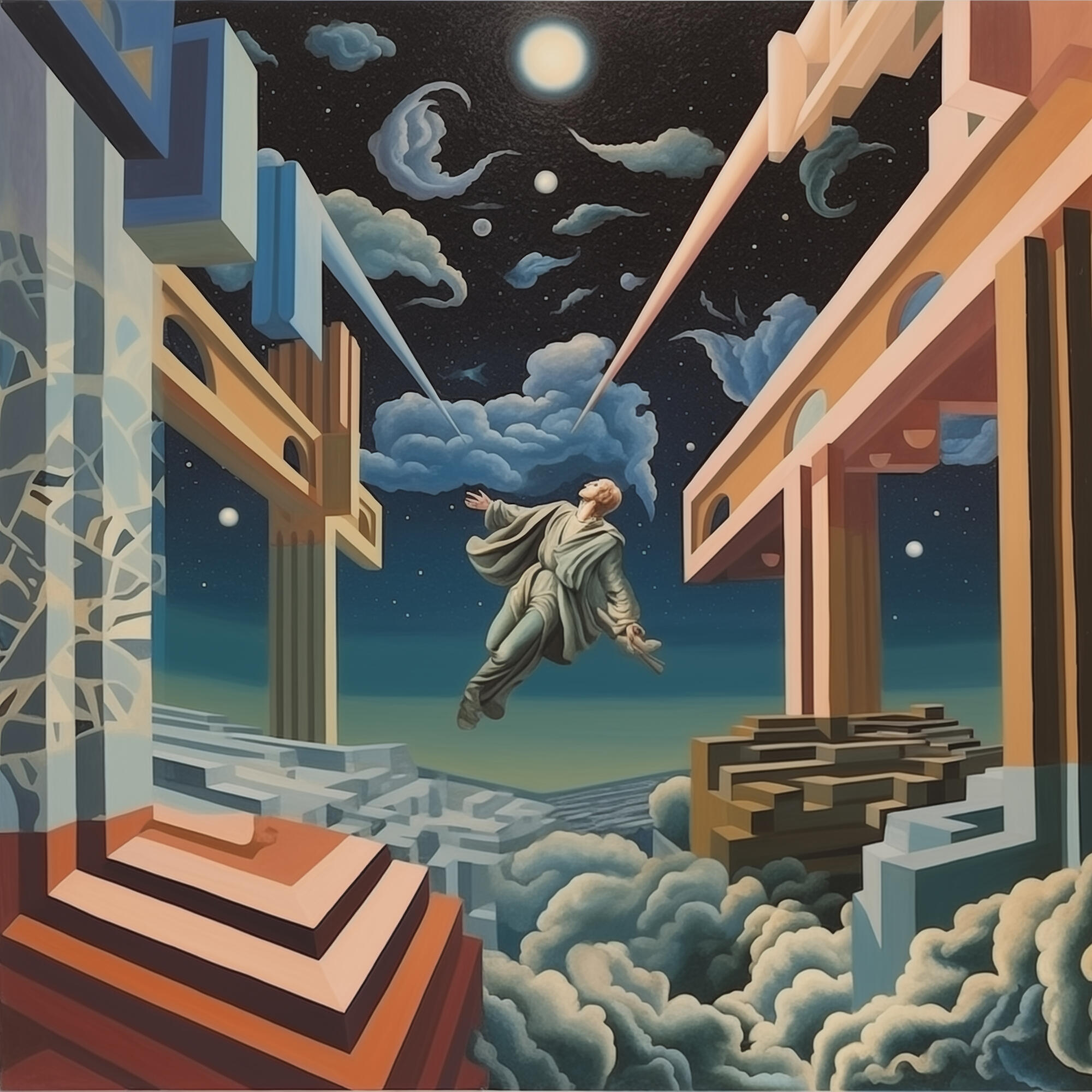
The Divine Comedy of Dante Alighieri, completed in 1319 shortly before the author’s death, is divided into three parts: Inferno, Purgatorio, and Paradiso. In the third part, Dante recounts his journey through the heavens. Beginning at the Garden of Eden, he travels through the nine concentric celestial spheres that compose the paradise, culminating in Empyrean, the dwelling-place of God. Empyrean is ethereal, non-material, and the source of light and creation. Over the course of his journey, Dante describes heaven in a way that often falls short of words, admitting that even poetry cannot fully express the ineffable glory of the heavens. The paradisiac experience transcends the human ability to discern and describe it, as the sight of the divine overwhelms and absorbs all of Dante's attention. “Our intellect so sinks into the deep / no memory can follow it that far.”Exactly seven hundred years after the completion of Paradiso, in 2019, a team of international scientists unveiled the first-ever image of a black hole. It was captured by the Event Horizon Telescope (EHT), a network of eight radio telescopes located across the globe. The image depicts a glowing ring of hot gas and dust encircling the dark central region of a black hole, located in the center of the M87 galaxy, 55 million light-years away from Earth. The image is humanity’s greatest attempt to describe the indescribable. It is astronomy’s Divine Comedy: an attempt to shine light on an inherently ineffable physical phenomenon.A black hole is a region in spacetime with a gravitational force so strong that nothing can escape from it, not even light. Most black holes are formed when a massive star reaches the end of its life and undergoes a process called a supernova explosion. After the explosion, the core of the star collapses in on itself, leading to an extreme concentration of mass in a very small area, which warps the fabric of spacetime around it, creating an immense gravitational pull.A black hole has two main parts: the event horizon and the singularity. The event horizon is an imaginary boundary that surrounds the black hole, acting as a point of no return for any matter or light that gets too close. Once something crosses the event horizon, it cannot escape the black hole's gravitational pull. At the center of the black hole lies the singularity, a point where its mass is compressed into an infinitely small space. An observer falling into a black hole, once crossing the event horizon, could not avoid being carried and crushed into the singularity, their mass added to the mass of the black hole.Despite the massive advances in modern physics of the last centuries, black holes remain the universe’s very own ineffable puzzle. The event horizon is much like Dante's boundary between earthly and divine knowledge. Black holes confront the limits of human understanding of the physical world, humbling us in the face of mysteries that may be fundamentally beyond our grasp.Now, let's propel ourselves seven hundred years into the future, landing in the year 2719. Over the past centuries, humanity has made remarkable strides in space exploration, having colonized the Moon, Mars, and the satellites of Jupiter and Saturn. The solar system is teeming with artificially-created superstructures, and long-distance galactic travel is safe and widely accessible. Astronomy’s latest discovery is Empyrean, a black hole detected a mere two light years away at the edges of the solar system, in the Oort cloud. Seven centuries after the first image of a black hole, a mission to visit one is launched — Operation Paradiso. Equipped with humanity’s latest technology and a sense of awe and wonder, the crew of the Paradiso spaceship sets out on the perilous journey to visit Empyrean. The idea of exploring one of the most enigmatic entities in the universe is both thrilling and terrifying.On its long journey traveling at near the speed of light, the spaceship is in constant radio communication with space bases on Earth and across the solar system. The day arrives when the spaceship is now ready to enter Empyrean. As predicted by General Relativity, radio transmissions from the spaceship wane into nothingness as the vessel crosses the black hole’s event horizon. Hours turn into days, days turn into weeks, weeks into years. No news. A deafening silence prevails when trying to make contact with Paradiso.Then, on a day like any other, the Paradiso spaceship reappears, returning from its mission. Humanity, scattered across the solar system, breathes a collective sigh of relief. The spaceship is cleared to land on a satellite station located on Titan, a moon of Saturn. Everyone is anxiously awaiting to know what it was like to be inside a black hole. But, when crew members are asked to describe their journey, words fail them. The crew smile as they look at one another, well aware that the ineffable beauty of their experience would remain untold.
Eclipses
Reckoning

In 1901, amidst the azure waters of the Aegean Sea, a remarkable discovery was made. A crew of sponge divers stumbled upon a mysterious device nestled within a shipwreck near the little island of Antikythera. It was a wooden box about one foot in height and heavily encrusted with algae. Upon opening it, the divers found a complex assembly of bronze gears and dials. It became immediately clear that it was an ancient mechanism. But of what kind? This ancient technology puzzled scientists and archaeologists for a century. Then, just a few years ago, they established that it is a machine to predict eclipses. This complex astronomical tool, now known as the Antikythera Mechanism, is the oldest known example of an analog computer. It was constructed by unknown Hellenistic scientists in the 2nd century BC and, to this day, it can predict eclipses with remarkable accuracy.Eclipses are captivating events in the celestial theater. They occur when the Earth, Moon, and Sun align in a straight configuration. During an eclipse, the stage is set for a magical interplay of light and shadows. Naturally, the light of the Sun is always “turned on”: shadows are being cast at all times. In this exact moment, dear reader, the Sun is shining its light both on the Earth and the Moon and respective shadows are being cast into space. When the Earth and Moon align, the shadow cast by one object will obscure, partially or totally, the other. A lunar eclipse occurs when the Earth interposes itself between the Sun and the Moon, casting a shadow on the lunar face. A solar eclipse happens when the Moon glides between the Earth and the Sun, casting a shadow upon the Earth and partially, or fully, obscuring the Sun's light in a specific region.Intriguingly, it is a cosmic coincidence that, in our current era, the angular diameter of Sun and Moon, as seen from Earth, are nearly identical. In a total solar eclipse, the Moon perfectly covers the Sun turning the day into night. Such a unique spectacle might have been the spark that ignited our ancestors' reckoning and a desire to start predicting these celestial events. Because the movements of celestial bodies are not random, eclipses follow predictable patterns. For example, the Moon completes an orbit around the Earth in a 28-day period — a lunar phase. And thus, a total lunar eclipse is reserved for the night of a full Moon, when the Moon is “in opposition”, while a total solar eclipse can only happen on a new Moon, when our satellite is “in between”. The periodic and regular movement of celestial bodies makes the choreography of eclipses governed by predictable mechanics which can be computed and forecast.In antiquity, our ancestors did not know that the Earth was a sphere, rotating on its axis, and orbiting around the Sun, but their keen observations led them to discern remarkable astronomical patterns. One of the most significant of these patterns, first identified by the Babylonians, is the Saros cycle, a period of 223 lunar months during which solar eclipses occur at regular intervals. However, the locations of these eclipses shift across the Earth's surface, and it takes three Saros cycles (about 54 years) for a solar eclipse to appear in a similar geographic location as a previous one. A long time, but one which could be observed and recorded — an example of our enduring quest to bring a sense of order and predictability to the natural world.Catapult yourself for a moment in the past, into the daily life of an ancestor of yours in 2nd century BC Greece. This ancestor, named Artemis, is a young and ingenious woman living in Antikythera. Word in the streets is that a miraculous celestial event is going to happen tomorrow, as predicted by a budding local scientist — part astronomer, part astrologer. This divination divides the town; some are captivated and interpret it as an omen; others, including your foremother, remain cautious and skeptical.Imagine the disbelief she would experience that next morning. As she is walking under the town stoa an extraordinary spectacle unfolds. Daylight suddenly transforms into twilight. The Sun dims and night falls in the middle of the day — with the sky turning dark and making way to twinkling stars. Imagine the surreal stillness that follows: the wind comes to a halt, animals, confused, engage in erratic behavior, birdsong stops, and a profound silence envelopes all of the agora. After minutes, which feel like hours, the sun magically reappears. Artemis is awestruck. She decides to devote her life to understanding this incredible phenomenon. She will predict the next eclipse.What happens next in this story may stretch the boundaries of your belief. What I am about to tell you may seem fantastical and improbable — the stuff of fantasy. But it is not impossible that this distant grandmother of yours, Artemis, was indeed the mastermind behind the Antikythera Mechanism. Her machine is a message to you from the ancient past, echoing through 123 Saros cycles. Through a baffling twist of cosmic destiny, you inherit Artemis's legacy. It is up to you, dear reader, to discover what universal riddle should be solved next. Never could Artemis have imagined the unfathomable array of open problems now laid before you: from the paradox of dark matter to the search for habitable exoplanets, from the origins of cosmic rays to the complexities of chaotic n-body systems, and beyond. What universal mystery are you poised to unravel? What powerful computer will you build to decode the celestial secrets of far away worlds? Now’s the time to reckon.

